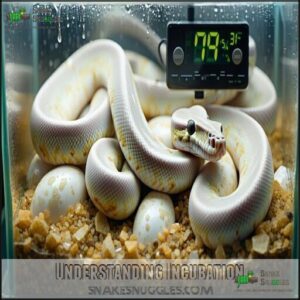This site is supported by our readers. We may earn a commission, at no cost to you, if you purchase through links.

Pair them during breeding season (October-February) in a clean enclosure with proper hiding spots. Monitor the female for follicle development—a telltale middle-body swelling.
Once breeding occurs, provide a nesting box for egg-laying. Incubate eggs at 88-90°F with 90-100% humidity for 50-60 days.
Like a watchful parent, you’ll need patience through each step. Even experienced breeders face challenges like reluctant males or fertility issues. The key lies in maintaining consistent temperatures and environmental conditions throughout the process.
Table Of Contents
- Key Takeaways
- How to Breed Ball Pythons?
- Checking Snake Maturity
- Introducing The Breeding Process
- Understanding Incubation
- Caring for Hatchlings
- Where to Obtain Necessary Supplies
- Frequently Asked Questions (FAQs)
- How to choose a ball python for breeding?
- How to expect upcoming eggs in Ball Pythons?
- How do you prepare a ball python for breeding?
- Do ball pythons breed well in captivity?
- How do I get my ball pythons to breed?
- Is breeding ball pythons difficult?
- How long do ball pythons take to breed?
- Can I let my ball python incubate her own eggs?
- How do you get ball pythons to breed?
- How long do you leave ball pythons together to breed?
- Conclusion
Key Takeaways
- You’ll need sexually mature ball pythons for breeding: females at 2-3 years old weighing at least 1500g and males at 1-1.5 years weighing at least 700g.
- You should introduce your snakes during breeding season (October-February) in a clean enclosure, watching for successful "locks" that may last several hours and monitoring the female for follicle development.
- You’ll need to maintain precise temperature (88-90°F) and humidity (90-100%) during the 54-60 day incubation period, which directly affects hatching success and potentially the sex ratio of your clutch.
- You shouldn’t worry if initial breeding attempts fail, as even experienced breeders face challenges like reluctant males or fertility issues—patience and consistent environmental conditions are essential throughout the process.
How to Breed Ball Pythons?
The journey of ball python breeding begins with proper preparation. To breed successfully, you’ll need mature specimens—females should weigh at least 1500 grams (typically 3+ years old), while males need to reach about 700 grams (around 16-18 months old).
Start by creating ideal breeding conditions. Gradually increase enclosure temperatures to 88-90°F during breeding season (November through March), mimicking their natural cycle.
When you introduce the male to the female’s habitat, watch for courting behaviors. Successful "locks" may last several hours—a good sign for genetic health and future offspring.
Nature’s dance: warm temperatures and proper timing transform ordinary ball pythons into proud parents.
For ethical breeding, monitor follicle development—an ultrasound can help track progress. Provide a damp egg-laying box for your gravid female. Regular veterinary check-ups are also essential for pre-breeding health. Be prepared for breeding challenges: males might refuse food, and cohabitation risks include occasional aggression. With patience through the reproduction cycle, you’ll soon welcome baby morphs into your collection.
Checking Snake Maturity
Now that you understand the basics, let’s verify if your snakes are ready to breed.
Determining maturity isn’t just about age—it’s about ensuring your pythons are physically prepared for reproduction. Males reach breeding readiness around 15-24 months at 700 grams minimum weight, while females need 24-36 months and at least 1200 grams.
Evaluating a snake’s age can also involve analyzing shedding frequency.
Here’s how to assess breeding readiness:
- Weigh regularly – track growth against age requirements
- Check body condition – look for good muscle tone without obesity
- Schedule a vet examination – confirm health before breeding
- Assess fat reserves – neither too thin nor overweight
- Verify physical indicators – clear eyes, smooth scales, proper proportions
Introducing The Breeding Process
You’ll start the ball python breeding process by carefully pairing your mature snakes during the cooling period from November to March, making sure they’re both healthy and properly sized.
Once paired, you’ll need to monitor them for successful mating behavior called "locking," which can last several hours and might look like they’re just having a really awkward snake hug.
Pairing
Now that you’ve confirmed your ball pythons meet the maturity requirements, it’s time for pairing.
Introduce males and females carefully, watching for signs of female receptivity. When pairing, place them in a neutral enclosure to reduce territorial behavior.
Males may need extra stimulation to initiate mating. When successful, they’ll enter a "lock" position for 3-4 hours.
Remember, sperm viability can last up to two years, so space out pairing frequency to avoid exhausting your male.
Follicle Development
Follicle development marks the fascinating biological process your female ball python undergoes before laying eggs.
The marvel of follicle growth: Nature’s intricate preparation for a ball python’s journey to laying healthy, viable eggs.
Once pairing succeeds, you’ll need to track her reproductive progress.
For successful monitoring:
- Gently palpate her mid-section weekly to feel marble-like follicles growing at 6-8mm per week
- Watch for her pre-ovulation shed when follicles reach 35-40mm in size
- Recognize ovulation when her mid-body swells to ping-pong ball size (28-30mm)
Maintain ideal health through this period with proper temperatures (88-90°F) to support hormonal influence on egg viability.
Your female should weigh at least 1,500 grams for safe fertility and successful egg deposition.
Troubleshooting: Males Not Eating
While females develop follicles, you might notice your male ball python turning down meals.
Don’t panic! Males often fast during breeding season as their focus shifts from food to finding mates.
Keep offering food every 7-10 days, but watch their weight carefully—losing more than 10% body mass is concerning.
Check enclosure temperature stays ideal (88-92°F hot side, 75-80°F cool side) to rule out temperature-related feeding issues.
Look for signs of parasites/illness or shedding issues that might affect appetite.
Snake health can decline from overbreeding effects, so limit breeding attempts if your male seems stressed.
If food refusal extends beyond two months outside breeding season, consult a reptile vet to address potential issues related to breeding season or other health concerns.
Preventing Mating Conflicts
While keeping an eye on your male’s feeding patterns, you’ll need to monitor pairing between your ball pythons carefully. Mating encounters aren’t always smooth sailing!
When introducing your snakes, always place the male in the female’s enclosure to reduce stress. This respects natural mating behavior and territory dynamics.
Males can get competitive, sometimes leading to male-on-male fighting if multiple suitors are present. Watch for signs of aggression like hissing or striking.
Proper space requirements help minimize cohabiting risks during breeding – each python should have adequate room to retreat if needed. Supervise interactions closely, especially during the first 30 minutes.
If you spot trouble, separate aggressors immediately and try again later. Your goal is a mixed-sex pair interacting calmly and naturally.
No Successful Mating Yet
Don’t worry if your ball pythons haven’t successfully mated yet. While managing conflicts is important, sometimes the issue stems from other factors.
When your breeding efforts feel like watching paint dry, remember that ball python breeders often wait months for success!
- When checking for issues, consider female receptivity by looking for restlessness or searching behavior. Verify environmental factors are proper with proper cooling-off periods (nights at 70°F).
Some pairing mistakes include rushing introductions or ignoring mating habits. Consider male infertility, which can be assessed through a vet health assessment.
Try mating stimulation by briefly housing males together before pairing. If you’ve verified both snakes are healthy, sometimes all that’s needed is patience. Many breeding ball pythons refuse to cooperate until their third or fourth introduction.
Understanding Incubation
You’ll need to maintain perfect conditions for your ball python eggs during the critical 54-60 day incubation period.
Creating the right temperature (around 88-90°F) and humidity (90-100%) environment gives your future snake babies the best chance of hatching healthy and strong.
Selecting an Incubator
With eggs on the way, selecting the right incubator becomes your next focus. The perfect incubator acts like a protective nursery for your python eggs, maintaining ideal conditions around the clock.
The key characteristics of a good incubator include stable temperature control, minimal fluctuations, and good ventilation. Look for models with these features to guarantee the best hatching conditions.
| Incubator Type | Key Features | Temperature Range | Price Range |
|---|---|---|---|
| Commercial | Digital controls, viewing window | 84-88°F | $100-300 |
| Professional | Multiple shelves, alarm systems | 82-90°F | $300-800 |
| Hovabator | Basic, reliable, smaller capacity | 84-86°F | $50-100 |
| C Serpents Hotbox | Excellent air circulation, larger capacity | 83-89°F | $150-250 |
To ensure the best results, consider purchasing a reptile breeding incubator. Digital thermostats and hygrometers aren’t just fancy add-ons—they’re essential for monitoring conditions that directly impact hatching success.
Choose an incubator size that accommodates your expected clutch plus extra space for proper air circulation. This will help create an optimal environment for your eggs to hatch.
DIY Incubator
After gathering your supplies, building a DIY ball python incubator can save you hundreds of dollars while ensuring perfect hatching conditions. You’ll need basic materials that are easy to find at hardware stores.
- Convert a cooler or mini fridge by removing the compressor and drilling entry holes for cables
- Install heat tape along interior walls and connect to a Herpstat thermostat for reliable temperature control
- Mount a small computer fan for proper air circulation throughout the incubator
- Place thermometer probes at different levels to monitor temperature consistency
- Use perlite mixed with water as your humidity regulation substrate
Test your setup for at least 48 hours before introducing eggs. Aim for a steady 88-90°F with humidity around 90%. Consistent monitoring is key, as temperature stability matters for healthy embryo development. With a digital thermometer monitoring conditions, you’ll create the perfect environment for those precious python eggs to develop properly, ensuring proper air circulation and humidity regulation.
Creating Proper Egg Environment
Your ball python’s precious eggs deserve a five-star environment to develop properly.
Setting up the perfect incubation substrate is like creating a cozy nursery for your future hatchlings.
| Factor | Ideal Range | Warning Signs |
|---|---|---|
| Humidity Control | 90-95% | Dimpling eggs |
| Temperature Stability | 84-88°F | Developmental issues |
| Substrate Choice | Vermiculite/perlite | Mold growth |
| Air Circulation | Gentle flow | Condensation buildup |
Mix your incubation substrate (vermiculite or perlite) with water at a 1:1 ratio by weight—moist enough to clump when squeezed but not dripping wet. For superior results, consider vermiculite as substrate.
Never rotate ball python eggs! Place them in their original orientation with small gaps between each egg to prevent sticking.
The perfect egg environment mimics natural conditions, giving your clutch the best chance at healthy development.
Determining Fertility Through Candling
The magical moment of candling your ball python eggs reveals whether your breeding efforts will succeed.
When checking egg viability, follow these simple tips:
- Use proper candling equipment – a small LED flashlight works perfectly
- Look for vein visibility – a network of red lines means fertility
- Note infertile indicators – clear or yellowish appearance without veins
- Practice early detection – check eggs within the first week
- Maintain proper candling frequency – once weekly is sufficient
In a dark room, gently press your light against each egg. Fertile eggs display a spider-web of blood vessels and a dark embryo spot. "It’s like looking at a little dragon growing in there," as one breeder puts it. Handle eggs minimally during candling to prevent damage.
You can find candling supplies online to aid in the process. Infertile eggs won’t show development and may appear more translucent or yellowish. Regular candling helps you monitor egg development and remove any bad eggs quickly. This process is critical for successful breeding and ensures the health of your eggs. By following these steps, you can increase your chances of having a successful hatch and healthy ball pythons.
Incubation Temperature Guidelines
Having confirmed your eggs are fertile through candling, your next mission is maintaining precise temperature control—the true secret to successful hatching.
Keep your incubation temperature between 84-88°F (28.8-31.1°C) for ideal development. Notably, temperatures at the higher end of this ideal temperature range tend to produce more females, while cooler temperatures favor males.
Install quality incubation thermometers and check readings daily to prevent temperature fluctuation risks that could harm embryo development. Studies show a direct hatch rate correlation with stable temperatures.
Position your incubator away from drafts, direct sunlight, and heating vents to guarantee consistent reptile incubation conditions. Maintain humidity at 90-95% throughout the 54-60 day snake incubation period.
Steady temperatures mean healthy baby ball pythons!
Caring for Hatchlings
Tiny hatchlings emerge from their eggs ready for a new chapter in your breeding journey. Caring for these delicate creatures requires attention to detail and patience.
Set up proper hatchling housing with:
- Small enclosures (10-gallon tanks) with secure lids to prevent escape
- Hiding spots that make your baby snakes feel safe and reduce stress
- Paper towel substrate for easy cleaning and monitoring
Offer pinkie mice 5-7 days after their first shed, which typically occurs within 7-10 days post-hatching. Don’t worry if they refuse food initially—this is normal.
Monitor their health by checking for clear eyes, smooth skin, and regular weight gain. Proper heat mat placement will help regulate temperature. Maintain 50-60% humidity and provide fresh water daily in shallow dishes to prevent drowning.
Where to Obtain Necessary Supplies
Now that your hatchlings are thriving, let’s focus on where you’ll find all those breeding supplies you need.
Finding the right equipment doesn’t have to break the bank. You can source quality snake breeding equipment from multiple places:
- Reptile Supply Stores and Online Retailers offer extensive selections including egg incubators, thermometers, hygrometers, and specialized substrates at competitive prices.
- Local Breeders and Herp Shows provide opportunities to purchase used equipment and get advice from experienced keepers.
Don’t overlook DIY options for budget-conscious setups. Many breeders create homemade incubators using plastic tubs and heat tape that work just as effectively as commercial units.
Check reptile forums for marketplace sections where keepers sell gently used equipment. Remember, reliable temperature control is worth investing in—your breeding success depends on consistent environmental conditions.
Frequently Asked Questions (FAQs)
How to choose a ball python for breeding?
Like picking a champion athlete, select healthy ball pythons that meet minimum requirements: males over 700g and 18 months old, females over 1,500g and 3 years old. Avoid obesity and genetic issues.
How to expect upcoming eggs in Ball Pythons?
Watch for a pre-lay shed 4-7 weeks before eggs arrive.
You’ll notice your female getting thicker mid-body and may see her coiling differently.
Provide a lay box with damp moss ready.
How do you prepare a ball python for breeding?
Verify your python meets size requirements—males need 700+ grams and females 1,500+ grams. Have a vet check before cycling. Gradually lower temperatures in October to mimic natural breeding conditions.
Do ball pythons breed well in captivity?
Ball pythons breed beautifully in captivity when properly prepared.
You’ll find they’re quite cooperative with correct conditions – cooling periods, appropriate weight requirements, and proper pairing.
They’re one of the most reliable reptiles for captive breeding success.
How do I get my ball pythons to breed?
To breed ball pythons, pair a 700+ gram male (1+ years old) with a 1,500+ gram female (3+ years old).
Create a cooling period with shorter days, then introduce them periodically between November and March.
Is breeding ball pythons difficult?
Breeding ball pythons isn’t as tough as you might think.
You’ll need patience, proper setup, and healthy snakes meeting size requirements.
The challenge comes with timing, temperature control, and monitoring the entire process carefully.
How long do ball pythons take to breed?
The complete breeding cycle takes 6-8 months. You’ll need 1-3 months for pairing, then approximately 30-50 days after ovulation for egg-laying, followed by 54-60 days of incubation before hatching occurs.
Can I let my ball python incubate her own eggs?
While your maternal serpent may desire to embrace motherhood naturally, it’s best to transfer her eggs to an incubator.
You’ll get better hatch rates and can monitor conditions more precisely than she can.
How do you get ball pythons to breed?
To breed ball pythons, lower temperatures to mid-70s°F during fall months.
Pair mature snakes (males 700g+, females 1500g+) and introduce them monthly, and wait for successful mating.
Provide a lay box once ovulation occurs.
How long do you leave ball pythons together to breed?
Like a tango that shouldn’t be rushed, you’ll want to leave ball pythons together for 3-4 days per pairing. You can reintroduce them every 1-2 weeks until you observe ovulation.
Conclusion
Mastering how to breed ball pythons represents an absolutely incredible journey of patience and precision.
You’ve now learned the essential steps: from selecting mature breeding pairs to witnessing your first hatchlings emerge.
Remember, success doesn’t happen overnight—consistent temperatures, proper nutrition, and attentive care are your best allies.
Whether you’re breeding for morphs or simply expanding your collection, each clutch brings new learning opportunities.
With these guidelines in hand, you’re well-equipped to set out on your ball python breeding adventure!














